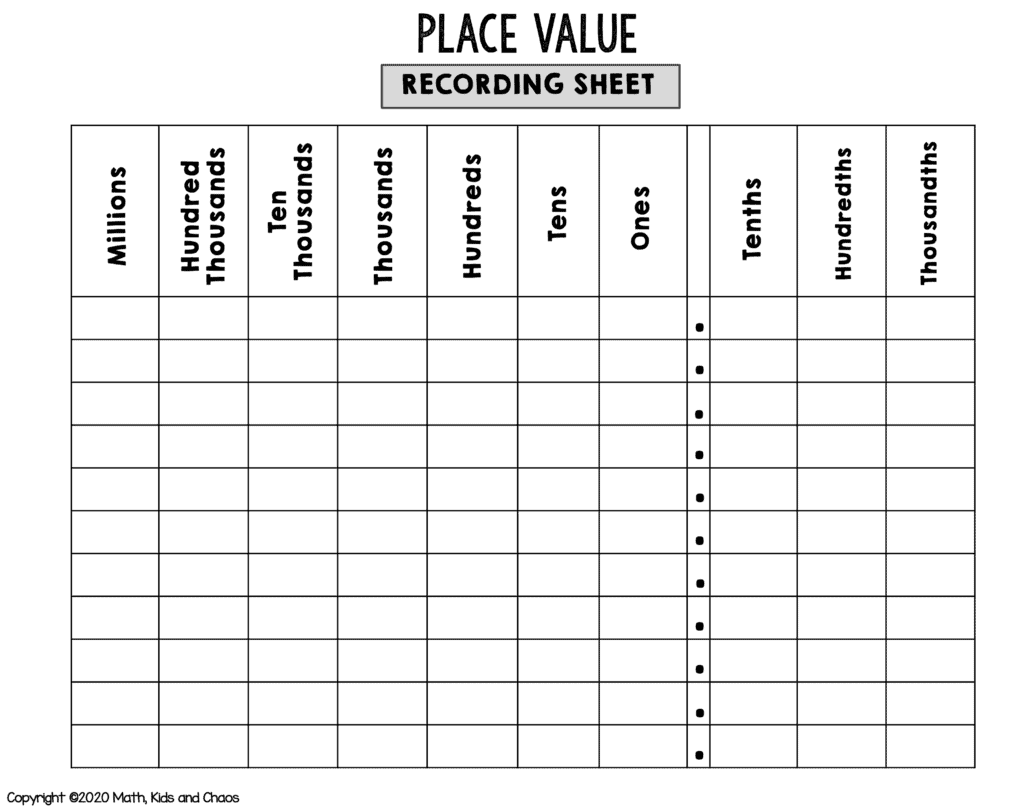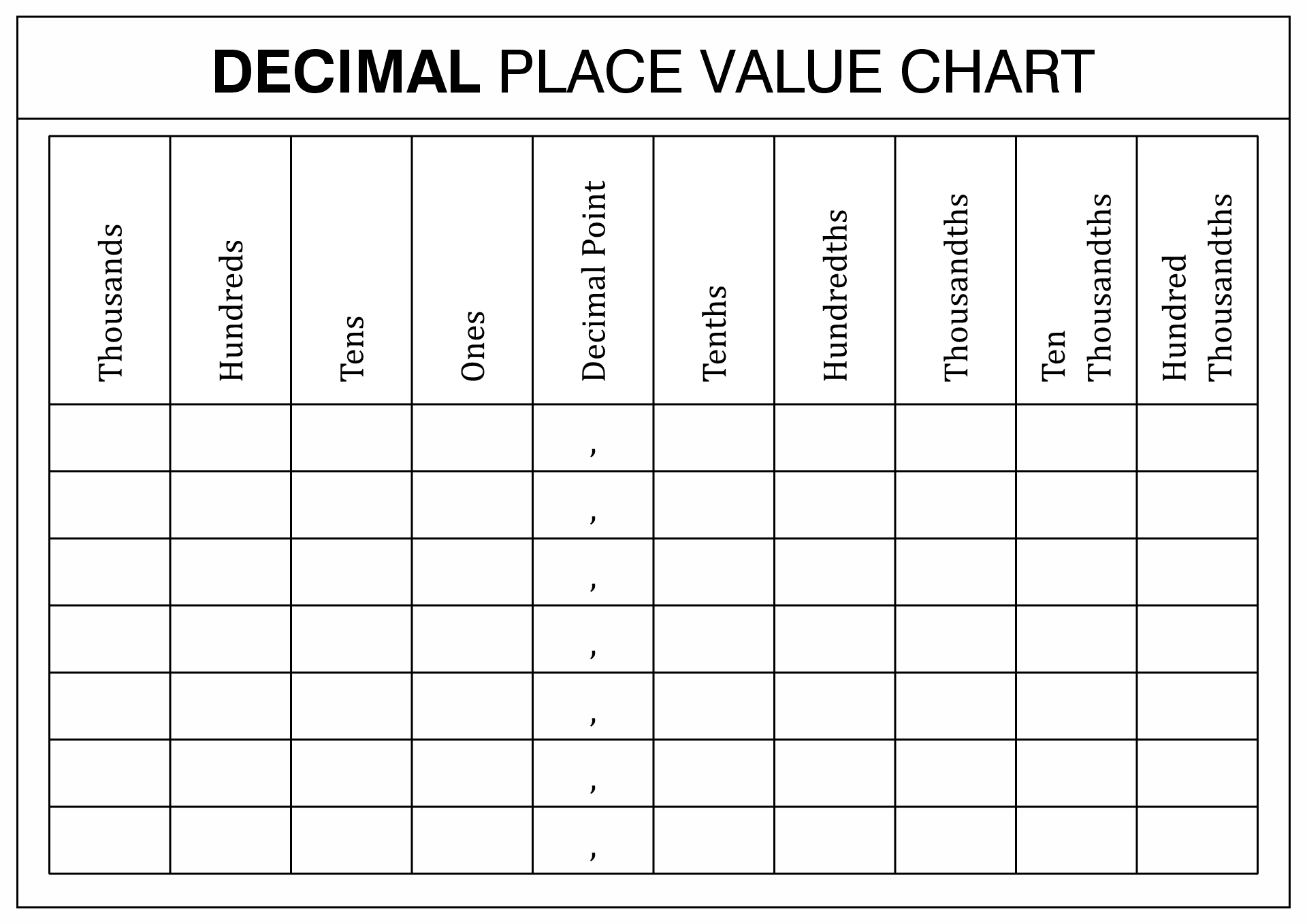A decimal place value chart is a useful tool for understanding and working with numbers that have decimal places. It helps us visualize the value of each digit in a decimal number and is essential for performing operations such as addition, subtraction, multiplication, and division. In this post, we will learn how to use a decimal place value chart and explore some printable charts that you can use for practice.
Understanding Decimal Place Value
Before we delve into the use of a decimal place value chart, let’s quickly review the concept of decimal place value. In a decimal number, each digit is assigned a place value based on its position relative to the decimal point. The rightmost digit represents the smallest unit, and each successive digit represents a value ten times greater than the previous digit.
For example, consider the decimal number 123.456. In this number:
- The digit 3 is in the “ones” place.
- The digit 2 is in the “tens” place.
- The digit 1 is in the “hundreds” place.
- The digit 4 is in the “tenths” place.
- The digit 5 is in the “hundredths” place.
- The digit 6 is in the “thousandths” place.
Having a clear understanding of decimal place value is crucial when performing operations with decimal numbers and comparing their values.
How to Use a Decimal Place Value Chart
To use a decimal place value chart, follow these steps:
- Draw a table with columns labeled “Place Value,” “Number,” and “Value.”
- In the “Place Value” column, list the place values from left to right, starting with the largest (e.g., millions, thousands, ones, tenths, hundredths, etc.).
- In the “Number” column, write the digits of the decimal number in the corresponding place value positions. If a place value is not occupied, write a zero in that position.
- In the “Value” column, write the value of each digit based on its place value. This can be calculated by multiplying the digit by the corresponding power of ten.
 Let’s illustrate this process using our example number 123.456:
Let’s illustrate this process using our example number 123.456:
- In the “Place Value” column, we would list “Ones,” “Tens,” “Hundreds,” “Tenths,” “Hundredths,” and “Thousandths.”
- In the “Number” column, we write the digits 1, 2, 3, 4, 5, and 6 in their respective places, leaving zeros in the thousands and millions places.
- In the “Value” column, we calculate the value of each digit using the corresponding power of ten. For example, the digit 3 in the “Hundreds” place has a value of 3 x 100 = 300.
By using a decimal place value chart, we can clearly see the value of each digit in a decimal number and understand its position relative to the decimal point. This understanding is essential for performing operations accurately and interpreting the results correctly.
Free Printable Decimal Place Value Charts
If you prefer to practice with physical charts or want to provide your students with additional resources, there are several printable decimal place value charts available online. These charts can be downloaded, printed, and used for educational purposes. Here are a few examples:
1. Free printable place value chart from Math, Kids, and Chaos
 This printable chart from Math, Kids, and Chaos includes color-coded sections for each place value. It also provides some fun activity ideas for practicing place value skills.
This printable chart from Math, Kids, and Chaos includes color-coded sections for each place value. It also provides some fun activity ideas for practicing place value skills.
2. Sample Decimal Place Value Chart Templates from Sample Templates
 Sample Templates offers various sample decimal place value chart templates that you can customize to your needs. These templates are available in MS Word and PDF formats.
Sample Templates offers various sample decimal place value chart templates that you can customize to your needs. These templates are available in MS Word and PDF formats.
3. Blank Place Value Chart with Decimals from Worksheeto
 This printable chart from Worksheeto allows you to fill in the decimal place values and numbers as needed. It’s great for creating custom practice sheets.
This printable chart from Worksheeto allows you to fill in the decimal place values and numbers as needed. It’s great for creating custom practice sheets.
Conclusion
A decimal place value chart is a valuable tool for understanding and working with decimal numbers. It helps us visualize the value of each digit and its position relative to the decimal point. By using a decimal place value chart, we can perform operations accurately and gain a deeper understanding of the numbers we work with. Printable decimal place value charts are available for additional practice and can be customized to meet specific educational needs. Start using a decimal place value chart today and enhance your number sense!